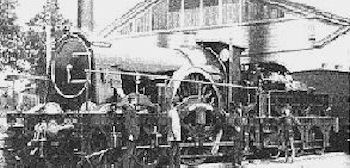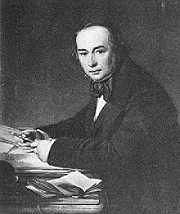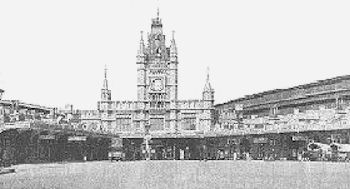
|
|
|
Great Western history, 1835 - 1892
The Great Western Railway was created by an Act of Parliament on the 31st August 1835 to provide a double tracked line from Bristol to London , however work had started in 1832 to secure finance for the line, research possible routes and design stations, bridges and all other buildings required. The next major priority was to appoint an engineer to oversee this construction. In 1833 this all important position went to the twenty-seven year old Isambard Kingdom Brunel. What he lacked in years he made up in sheer ability, as shown by his plans of the Clifton Suspension Bridge. The estimated price of the route was to be £2,800,000 but the line was to be of the 7 feet 0¼ inch (214 cm) broad gauge instead of the standard 4 feet 8½ inches (143.5 cm) standard gauge. Brunel's argument for its use were increased speed and higher passenger comfort.
stations, bridges and all other buildings required. The next major priority was to appoint an engineer to oversee this construction. In 1833 this all important position went to the twenty-seven year old Isambard Kingdom Brunel. What he lacked in years he made up in sheer ability, as shown by his plans of the Clifton Suspension Bridge. The estimated price of the route was to be £2,800,000 but the line was to be of the 7 feet 0¼ inch (214 cm) broad gauge instead of the standard 4 feet 8½ inches (143.5 cm) standard gauge. Brunel's argument for its use were increased speed and higher passenger comfort.
Construction of the line started in 1836 at two locations; between Bristol and Bath, and Reading and London, eventually reducing the gap between them. In addition, grand stations were built at Bristol - Temple Meads, and London - Paddington together with numerous other designs such as a carriage and locomotive works in Swindon.
The first section of twenty-four miles from Paddington to Maidenhead was completed in May 1838, but it was not until June 1841 that the line from Bristol to London, soon nicknamed as 'Brunel's billiard table' was completed at a total cost of £6,500,000. Swindon went into history by installing the first ever railway refreshment rooms for the public. A stop  of ten minutes was given, although before long the GWR would curse this facility as it prevented the speeding up of trains, until in May 1845, the company announced new express services to Exeter without this interruption. However the GWR was taken to court by the buffet leasee, with the company losing their case and in the process learning a valuable lesson.
of ten minutes was given, although before long the GWR would curse this facility as it prevented the speeding up of trains, until in May 1845, the company announced new express services to Exeter without this interruption. However the GWR was taken to court by the buffet leasee, with the company losing their case and in the process learning a valuable lesson.
Prior to this time, in 1837, the Great Western also launched their first ship, appropriately named 'Great Western', as Bristol had direct access to the Atlantic and America. A few years later they produced the first completely iron steamship 'Great Britain' and her troublesome sister 'Great Eastern', all designed by Brunel.
1843 saw the completion of Swindon locomotive works and soon afterwards the first GWR designed engine, inevitably named 'Great Western'. The year also saw extensions being made to the Great Western network so that by 1848, 250 miles of broad gauge track spread from Bristol. However, problems were encountered at towns such as Gloucester where the Great Western provided its broad gauge track from the south of the town met the Gloucester and Birmingham standard gauge track from the north. Eventually in 1846 an Act was passed initially preventing the GWR from building new broad gauge lines but a compromise was reached which provided for mixed gauge, with three rails instead of two enabling trains of different gauge to travel the same route.
The death of Brunel in 1859 shocked the Great Western severely. His creative genius saw most of his work completely fulfilled except for the problems with the ship 'Great Eastern' and the Clifton Suspension bridge which would be finished in 1864 after 30 years construction. It was on the 'Great Eastern' that Brunel suffered a heart attack and died on the 15th of September. He was buried at Kensal Green cemetery in London, not far from his own Paddington station.
If Brunel was the first figurehead to be lost, the second was Gooch, who resigned in 1864. His designs for Locomotives spear-headed the classic GWR image and he was succeeded by his deputy Joseph Armstrong. Soon afterwards though, Gooch was elevated to Chairman of the Great Western Railway. Armstrong inherited a network of 594 miles of broad gauge, 192 miles of mixed gauge and 406 miles of standard gauge; a total of just under 1200 miles spread throughout the West, Wales and the Midlands.
Coal was naturally the most important running commodity that the GWR had to buy as all of its locomotives ran entirely on burnable fuel. This enabled the coal merchants and suppliers to virtually hold the GWR to ransom knowing that the company could not operate without it. Therefore in May 1878, the Great Western began its own mining operations in Blaenavon, Wales. Eventually, this gave employment to 2500 miners and provided the company with cheaper coal.
In 1877, Joseph Armstrong died promoting his assistant, William Dean to Locomotive Superintendent. Armstrong's designs  had continued Gooch's work in the classic 2-2-2 configuration, but Dean produced elegant 4-2-2 singles with polished brass safety valves and steam dome covers and whistles, brass beading around the splashers and number plates, and copper tops to the chimneys. However the design to which he is best remembered was the Dean Goods 0-6-0. At the time of his appointment, Dean inherited 1536 miles of standard gauge, 274 miles of mixed gauge and just 275 miles of broad gauge.
had continued Gooch's work in the classic 2-2-2 configuration, but Dean produced elegant 4-2-2 singles with polished brass safety valves and steam dome covers and whistles, brass beading around the splashers and number plates, and copper tops to the chimneys. However the design to which he is best remembered was the Dean Goods 0-6-0. At the time of his appointment, Dean inherited 1536 miles of standard gauge, 274 miles of mixed gauge and just 275 miles of broad gauge.
August 1885 saw the arrival of the first 50 years of the Great Western Railway. In that time, the company had seen capital rise from £2,500,000 to £90,000,000 and from being a one route system to a network of over 2,300 miles of track reaching every corner of western England and Wales. In addition, the GWR owned 1,600 locomotives and 48,000 other vehicles, ranging from coal wagons to the latest saloons. The following year would see their proudest achievement yet; the opening of the Severn Tunnel. Construction of the 4½ mile tunnel under the River Severn began in 1873, but the cost to put Cardiff one hour nearer to London and Bristol was nearly £2million - a vast amount of money at the time. Fittingly the first train to run through the tunnel was filled with South Wales coal.
On the 23rd May 1892, the last of Brunel's exclusive empire, the 7 feet 0¼ inch broad gauge, was lifted. One result of the changeover was the biggest congregation of withdrawn steam locomotives in any one place until British Railways ended all steam working. In addition, thousands of carriages and wagons waited to be scrapped or converted to standard gauge.
Copyright © by John Daniel 2013.
